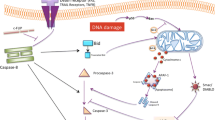Abstract
Treatment of HL60 and Jurkat leukaemic cell lines, both not expressing p53, with the new non-covalent DNA minor groove binder α-bromoacryloyl-distamycin (PNU 151807), induces apoptosis as shown either morphologically or by DNA laddering formation. We evaluated the p53-independent mechanisms of activation of apoptosis in these cell systems, by determining the levels of different caspases at different times after treatment with PNU 151807. Through Western blotting analysis we could measure the cleavage of the 110 Kd form of PARP in both HL60 and Jurkat cells and correspondingly the activation of CPP32-caspase 3. The levels of caspase-1 did not change at any time after drug treatment. By using the tetrapeptidic sequence recognized by caspase-3 (DEVD-AMC) or by caspase-1 (YVAD-AMC) linked to fluorogenic substrate, we also demonstrated that only the DEVD sequence was recognized and cleaved after drug treatment, while no significant changes were found for YVAD peptides. PNU 151807-induced DNA fragmentation and DEVD-cleavage were both inhibited by concomitant treatment with the specific inhibitor DEVD-CHO, but not by YVAD-CHO, clearly demonstrating the direct activation of caspase-3-like caspases in the induction of programmed cell death in these cell lines after minor groove binder exposure.
Similar content being viewed by others
References
D'Alessio R, Geroni C, Biasoli G, Pesenti E, Grandi M, Mongelli N. Structure activity relationship of novel distamycin A derivatives: synthesis and antitumour activity. Bioorganic Med Chem Lett 1994; 4: 1467-1472.
Marchini S, Ciro M, Gallinari F, et al. α-bromoacryloyl derivative of distamycin A (PNU 151807): a new non covalent minor groove DNA binder with antineoplastic activity. Br J Cancer 1999 (in press).
Hurley LH, Reynolds VL, Swenson DH, Petzold GL, Scahill TA. Reaction of the antitumoural antibiotic CC-1065 with DNA: structure of DNA adduct with sequence specificity. Science 1984; 226: 843-844.
Broggini M, Erba E, Ponti M, et al. Selective DNA interaction of the novel distamycin derivative FCE 24517. Cancer Res 1991; 51: 199-204.
Geroni C, Pesenti E, Tagliabue G, et al. Establishment of L1210 leukemia cells resistant to the distamycin-A derivative (FCE 24517): characterization and cross-resistance studies. Int J Cancer 1993; 53: 308-314.
Shao RG, Shimizu T, Pommier Y. 7-Hydroxystaurosporine (UCN-01) induces apoptosis in human colon carcinoma and leukemia cells independently of p53. Exper Cell Res 1997; 234: 388-397.
Vikhanskaya F, Vignati S, Beccaglia P, et al. Inactivation of p53 in a human ovarian cancer cell line increases the sensitivity to paclitaxel by inducing G2/M arrest and apoptosis. Exper Cell Res 1998; 241: 96-101.
Ibrado AM, Huang Y, Fang G, Liu L, Bhalla K. Overexpression of Bcl-2 or Bcl-xL inhibits Ara-C-induced CPP32/Yama protease activity and apoptosis of human acute myelogenous leukemia HL-60 cells. Cancer Res 1996; 56: 4743-4748.
Martins LM, Mesner PW, Kottke T, et al. Comparison of caspase activation and subcellular localization in HL-60 and K562 cells undergoing etoposide-induced apoptosis. Blood 1997; 11: 4283-4296.
Sambrook J, Fritsh E, Maniatis T. Molecolar Cloning: A Laboratory Manual. Cold Spring Harbor, NY USA: Cold Spring Harbor Laboratory Press, 1989.
Chen Z, Naito M, Mashima T, Tsuruo T. Activation of actincleavable interleukin 1beta-converting enzyme (ICE) family protease CPP-32 during chemotherapeutic agent-induced apoptosis in ovarian carcinoma cells. Cancer Res 1996; 56: 5224-5229.
Miossec C, Duttileul V, Fassy F, Hercend AD. Evidence for CPP32 activation in the absence of apoptosis during Tlymphocyte stimulation. J Biolog Chem 1997; 272: 13459-13462.
Blagosklonny MV, Schulte TW, Nguyen P, Trepel J, Neckers L. Taxol-induced apoptosis and phosphorylation of bcl-2 protein involves c-raf-1 and represents a novel c-raf-1 signal transduction pathway. Cancer Res 1996; 56: 1851-1854.
Broggini M, Coley HM, Mongelli N, et al. DNA sequence-specific adenine alkylation by the novel antitumour drug tallumustine (FCE 24517), a benzoyl nitrogen mustard derivative of distamycin. Nucleic Acid Res 1995; 23: 81-87.
Suzuki A, Kato M. Chemotherapeutic agent CPT-11 induces the new expression of the apoptosis initiator to the cytoplasm. Exper Cell Res 1996; 227: 154-159.
Author information
Authors and Affiliations
Rights and permissions
About this article
Cite this article
Marchini, S., Ciro', M. & Broggini, M. p53-Independent caspase-mediated apoptosis in human leukaemic cells is induced by a DNA minor groove binder with antineoplastic activity. Apoptosis 4, 39–45 (1999). https://doi.org/10.1023/A:1009630132087
Issue Date:
DOI: https://doi.org/10.1023/A:1009630132087




